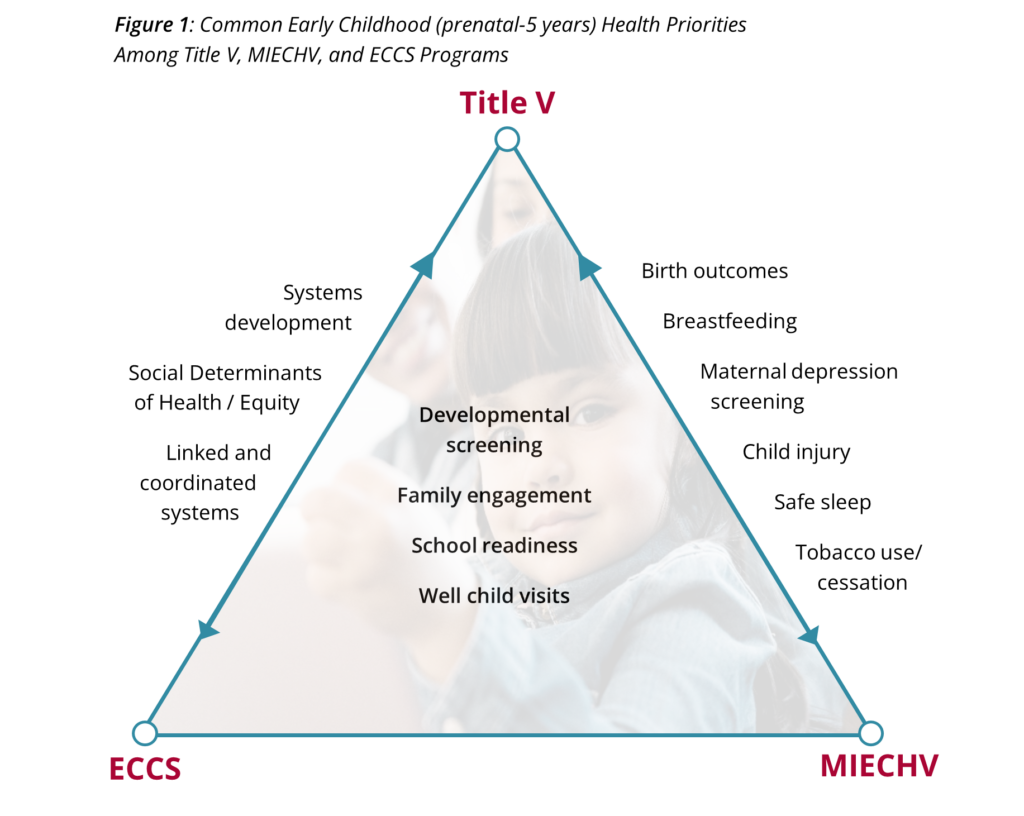Language: English
Year Created: 2021
Topic Tags: Child Health
File Type: PDF Interactive Content
Resource Type: Toolkit Infographic
Overview
 This is an accessible web-based collection of resources centered around AMCHP’s framework for collaboration among Title V, Maternal, Infant, and Early Childhood Home Visiting (MIECHV), and other Early Childhood Systems (ECS) programs. This framework is focused on systems building and provides practical tools for staff from each of the programs to utilize in strategically aligning their program goals and resources towards a common early childhood goal. “A Roadmap for Collaboration among Title V, Home Visiting, and Early Childhood Systems Programs”, developed in partnership with HRSA MCHB, first debuted in 2020 and was then updated in 2021 based on further pilot testing to include additional case studies and tips for implementing the framework for collaboration in 100% virtual settings.
This is an accessible web-based collection of resources centered around AMCHP’s framework for collaboration among Title V, Maternal, Infant, and Early Childhood Home Visiting (MIECHV), and other Early Childhood Systems (ECS) programs. This framework is focused on systems building and provides practical tools for staff from each of the programs to utilize in strategically aligning their program goals and resources towards a common early childhood goal. “A Roadmap for Collaboration among Title V, Home Visiting, and Early Childhood Systems Programs”, developed in partnership with HRSA MCHB, first debuted in 2020 and was then updated in 2021 based on further pilot testing to include additional case studies and tips for implementing the framework for collaboration in 100% virtual settings.
This resource re-launch in 2023 focused on increasing digital accessibility of the resource and includes the following sections:
- Analysis and Recommendations: Discover the results of our qualitative analysis of the facilitators and barriers to ECS program collaboration and ten recommendations for leaders to improve collaboration.
- Refined Collaboration Framework: Explore this thoroughly pilot-tested framework with practical and replicable strategies on how to better work together to create meaningful change and accomplish shared goals. State-level ECS leaders can also adapt it to increase collaboration in leveraging shared measures.
- Apply Real-world Case Studies: Learn from the successes of Guam, Indiana, Louisiana, and Mississippi as they demonstrate how their Title V, MIECHV, and ECS programs came together to implement the framework.
- Infographic on Provider Outreach: As an added bonus, the newly relaunched Roadmap resource features an infographic created in collaboration with Georgetown University School of Medicine’s Population Health Scholar Program. This infographic presents the results of an analysis of AMCHP survey data on what factors are associated with a coordinated intake and referral system having outreach to different types of healthcare providers.
Who is this resource for?
This resource was developed for anyone who oversees or supports the implementation of Title V, MIECHV, Early Childhood Comprehensive Systems (ECCS), and/or other early childhood systems-building programs and initiatives, but it will also be of interest and use to state and local decision-makers, public health professionals and leaders, students, policymakers, and anyone interested in how these early childhood systems and programs work together.
Background
Optimizing statewide early childhood systems so that children can reach their full potential is a key priority for the Health Resources & Services Administration’s (HRSA) Maternal and Child Health Bureau (MCHB).
This commitment is actualized through MCHB’s investment in these three early childhood-related programs:
- Title V Maternal and Child Health (MCH) Services Block Grant
- Maternal, Infant, and Early Childhood Home Visiting (MIECHV) Program
- Early Childhood Comprehensive Systems (ECCS) Program.
Use the dropdown below for MCHB Program Descriptions and relevant authorizing legislation for the three programs.
The MCH Services Block Grant (Title V of the Social Security Act)
Authorized by the Social Security Act in 1935, the Title V MCH Services Block Grant is one of the largest federal block grant programs providing states and jurisdictions with support for promoting and improving the health and well-being of the nation’s mothers, children, including children with special needs, and their families. The legislation requires that each state and jurisdiction conduct a comprehensive needs assessment every five years. States and jurisdictions use the findings of the needs assessment to select priorities for targeted focus and determine which of the 15 National Performance Measures (NPMs) they will address. Each state or jurisdiction also must select at least one NPM for each of the five population domains MCH programs are required to address:
• Women/maternal
• Perinatal/infant
• Child
• Adolescent
• Children with special health care needs.
Maternal, Infant, and Early Childhood Home Visiting (MIECHV) Program
’This program was established by The Patient Protection and Affordable Care Act under section 511 of the Social Security Act in March 2010. Administered by HRSA MCHB in partnership with the Administration for Children and Families, the MIECHV program funds grants to states and jurisdictions to provide pregnant people and families the necessary resources and skills to raise children who are physically, socially, and emotionally healthy and ready to learn.
The MIECHV program supports home visiting for under-resourced pregnant people and children and their families until the child enters kindergarten. Home visiting helps prevent child abuse and neglect, supports positive parenting, improves maternal and child health, and promotes child development and school readiness. MIECHV benchmarks for success include improvements in:
- Maternal and newborn health
- Maltreatment and reduction of emergency department visits
- School readiness and achievement
- Rates of domestic violence
- Economic self-sufficiency
- Coordination and referrals ¹
MCHB’s Early Childhood Systems (ECS) Portfolio
This portfolio of work includes several ECS programs that focus on supporting the healthy development of all children, starting prenatally, through the development of “comprehensive, coordinated, equitable services that promote success in both school and life.” Early childhood systems programs support leadership and the capacity to create, maintain and expand organized and purposeful partnerships, processes, strategies, training, policies, and other infrastructure required to systematically improve the lives of families and communities for generations. Notably, the ECS portfolio of work emphasizes a two-generation approach to early childhood systems work at both the state and local levels. One of the programs under the ECS umbrella includes the Early Childhood Comprehensive Systems (ECCS) program. HRSA has been committed to the ECCS program since 2002. Many of today’s early childhood systems initiatives are built on the foundations and successes of ECCS. The ECCS Health Integration Prenatal-to-Three Program (2021-2026) is the latest iteration of ECCS and aims to build state capacity and infrastructure to integrate and strengthen maternal and early childhood systems.²
|
Title V MCH Services Block Grant Program |
|
MIECHV Program |
|
|
ECS Programs |
|
|
Needs Assessment Resources |
How to Interact with This Resource
Creating a Roadmap required several activities.
Download the complete documentation of all activities as one PDF by clicking on the image to the right.
-OR-
Interact with each of the activities below.

RECOMMENDATIONS FOR IMPROVED ALIGNMENT AMONG EARLY CHILDHOOD PROGRAMS AT THE STATE AND LOCAL LEVEL.
Here you will find an overview of the environmental scan and qualitative analysis of facilitators and barriers to collaboration among HRSA-funded early childhood programs in states and jurisdictions.

A ROADMAP FOR EARLY CHILDHOOD SYSTEMS COLLABORATION.
Find a common route for collaboration through this refined framework with practical and replicable strategies for how ECS programs can better work together for meaningful change, accomplish shared goals, and leverage shared measures.
APPLY THE ROADMAP FRAMEWORK.
Navigate through the case studies below from Guam, Indiana, Louisiana, and Mississippi. These states and jurisdictions received intensive technical assistance from AMCHP in 2020-2021 to pilot the Roadmap framework by developing an action plan to improve collaboration to achieve a shared priority across their Title V, MIECHV, and ECCS programs.

Partnering with Purpose: Strengthening Alignment between Guam’s MCH Programs and the Child Care Sector

Enhancing the Indiana State Department of Health’s Internal Structure for Improved Early Childhood Collaboration

Prioritizing Family Engagement in Louisiana for Improved Early Childhood Collaboration

Accomplices in Action: Early Childhood Collaboration to Build More Equitable Support Systems for School Readiness

FUTURE DESTINATIONS.
From late 2021 to the present, AMCHP’s early childhood collaboration work has focused on centralized intake and referral systems (CIRS) because these have a high potential impact and benefit for families, but also a high need for coordination across the many systems and programs that support young children and their families. CIRS are just one example of a shared priority that early childhood programs can collaborate on using AMCHP’s Roadmap for Collaboration to improve health outcomes for children and their families. In 2022, AMCHP created and sent a survey to Title V MCH, MIECHV, ECCS, and CCDF program staff asking about their involvement in efforts to better coordinate early childhood services. AMCHP is currently working to publish a resource summarizing the complete findings from this work. View this resource, “A Snapshot of the Role of General Healthcare and Behavioral Healthcare Provider Outreach in Coordinated Intake and Referral Systems”, presenting the results of an analysis of survey data on what factors are associated with a CIRS having outreach to different healthcare providers.
If you have additional questions or are interested in receiving technical assistance related to implementing this roadmap, you can contact Maura Leahy (MLeahy@amchp.org).
Key Resources
The list below is by no means exhaustive but includes resources that complement and are referenced throughout this package of resources.
- Mind Tools’ Impact Matrix Worksheet
- FSG’s Guide to Actor Mapping
- National MCH Workforce Development Center’s Asset Mapping Tool
- FSG’s Water of Systems Change Framework
- FSG’s Water of Systems Change Action Learning Exercise
- Institute of Cultural Affairs’ Technology of Participation Action Planning Framework
References
The list below includes all of the references included as endnotes across the entire package of resources.
- Health Resources and Services Administration. (June 2023). Maternal, Infant, and Early Childhood Home Visiting (MIECHV) Program. Retrieved August 8, 2023, from https://mchb.hrsa.gov/programs-impact/programs/home-visiting/maternal-infant-early-childhood-home-visiting-miechv-program
- Health Resources and Services Administration. (October 2021). Early Childhood Comprehensive Systems Health Integration Prenatal-to-Three Program Awards. Retrieved August 8, 2023, from https://mchb.hrsa.gov/early-childhood-comprehensive-systems-health-integration-prenatal-three-eccs-program-awards
- Willis, D., Johnson, K. (April 2020). The collaboration and alignment of MCHB’s early childhood investments through Title V, MIECHV, and ECCS Impact programs: A qualitative analysis. Prepared for AMCHP by the Center for the Study of Social Policy and Johnson Group Consulting, Inc.
- Neuendorf, K. A. (2002). The content analysis guidebook. Thousand Oaks, CA: SAGE Publications.
- Crabtree, B. F. & Miller, W. L. (1999). “Using codes and code manuals: A template organizing style of interpretation.” In Doing qualitative research (2nd edition). Crabtree, B. F. and Miller, W. L. (eds.). Thousand Oaks, CA: SAGE Publications.
- Ulin, P. R. & Robinson, E. T. (2005). Qualitative methods in public health: A field guide for applied research. Tolley EE (eds.). San Francisco, CA: Jossey-Bass.
- Pope, C., Ziebland, S., & Mays, N. (2000). Qualitative research in health care: Analysing qualitative data. BMJ. 320, 114‒116.
- Miles, M. B., & Huberman, M. A. (1994). Qualitative data analysis: An expanded sourcebook. (2nd Edition). Thousand Oaks, CA: SAGE Publications.
- While there are many facilitation methods available for action planning, in this project, AMCHP staff used the Institute of Cultural Affair’s Technology of Participation Action Planning Framework.
Funding Acknowledgment
This project is supported by the Health Resources and Services Administration (HRSA) of the U.S. Department of Health and Human Services (HHS) under grant number U01MC0001 – Partnership for State Title V MCH Leadership Community Cooperative Agreement ($1,738,864). This information or content and conclusions are those of the author and should not be construed as the official position or policy of, nor should any endorsements be inferred by HRSA, HHS, or the U.S. government.

